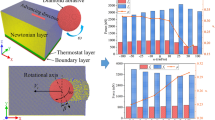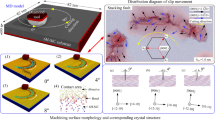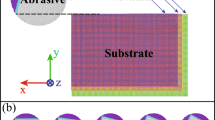Abstract
In order to clarify the mechanism of polishing of double diamond abrasive particles, in this study, the mechanism of material removal and the evolution of single crystal Si workpiece surface under the three-body polishing condition were investigated. The effect of the depth of polishing and the transverse/longitudinal spacing of the double abrasive grains on the three-body polishing were examined. The purpose is to reveal the phase transition, surface morphology, surface damage, material removal rate, temperature, potential energy, and friction force for polishing Si wafer. The analysis of coordination number clarified that the number of phase transition atoms by polishing and abrasion increased with increasing polishing depth and transverse distance of the nanoparticles on the Si work surface, but not especially obvious with increasing longitudinal spacing. Temperature analysis shows that when the polishing depth is 1 nm, the polishing temperature is 456 K, while when the polishing depth is 3 nm, the polishing temperature is 733 K. The temperature difference between the longitudinal group and the transverse group is only 30–40 K. The larger the transverse abrasive grain spacing or the smaller the polishing depth, the smaller the surface roughness; however, the longitudinal abrasive grain spacing has no obvious correlation with the surface roughness.













Similar content being viewed by others
References
Saga, T.: Advances in crystalline silicon solar cell technology for industrial mass production. NPG Asia Mater. 2, 96–102 (2010)
Ge, M., Zhu, H., Huang, C., et al.: Investigation on critical crack-free cutting depth for single-crystal silicon slicing with fixed abrasive wire saw based on the scratching machining experiments. Mater. Sci. Semicond. Process. 74, 261–266 (2018)
Zhao, Y., Kunieda, M., Abe, K.: Comparison on foil EDM characteristics of single crystal SiC between in deionized water and in EDM oil. Int. J. Adv. Manuf. Technol. 86, 9–12 (2016)
Yin, J., Bai, Q., Li, Y., Zhang, B.: Formation of subsurface cracks in silicon wafers by grinding. Nanotechnol. Precis. Eng. 103, 172–179 (2018)
Zhao, Z., To, S., Xiao, G., Jelenković, E.V.: Effects of cutting angles on deformation of single crystal silicon in plunge cutting along 〈1 0 0〉 direction. Mater. Lett. 253, 234–237 (2019)
Luo, Y,, Akkurt, N., Zhang, K., et al.: Molecular investigation on the anomalous phenomenon at liquid desiccant surfaces for air conditioning. In: Building Simulation, vol. 13(3), pp. 599–608. Tsinghua University Press (2020)
Li, P., Chen, S., Dai, H., Yang, Z., Chen, Z., Wang, Y., Chen, Y., Shan, W., Peng, W., Duan, H.: Recent advances in focused ion beam nanofabrication for nanostructures and devices: fundamentals and applications. Nanoscale 13, 1529–1565 (2021)
Vacher, R., de Wijn, A.S.: Nanoscale simulations of wear and viscoelasticity of a semi-crystalline polymer. Tribol. Lett. 69(1), 1–12 (2021)
Liang, B., Liu, Y., Xu, Y.: Silicon-based materials as high capacity anodes for next generation lithium ion batteries [J]. Power Sour. 267, 469–490 (2014)
Xiao, Y., Chen, C., Cao, S., et al.: Enhanced sunlight-driven photo-catalytic activity of graphene oxide/Bi2WO6 nanoplates by silicon modifcation. Ceram. Int. 41(8), 10087–10094 (2015)
Liu, Y., Tai, Z., Zhou, T., et al.: An all-integrated anode via inter-linked chemical bonding between double-Shelled–Yolk-structured silicon and binder for lithium-ion batteries. Adv. Mater. 29(44), 1703028 (2017)
Lee, W.B.R., Wang, H., To, S., Cheung, C.F., Chan, C.Y.: Mesoplasticity approach to studies of the cutting mechanism in ultra-precision machining. Chin. J. Mech. Eng. 27(02), 219–228 (2014)
Goel, S., Luo, X., Reuben, R.L.: Wear mechanism of diamond tools against single crystal silicon in single point diamond turning process. Tribol. Int. 57, 272–281 (2013)
Goel, S.: The current understanding on the diamond machining of silicon carbide. Phys. D Appl. Phys. 47, 113–116 (2014)
Zhang, L., Zhao, H., Ma, Z., et al.: A study on phase transformation of monocrystalline silicon due to ultra-precision polishing by molecular dynamics simulation. AIP Adv. 224, 8991 (2012)
Shi, X., Pan, G., Zhou, Y., Xu, L., Zou, C., Gong, H.: A study of chemical products formed on sapphire (0001) during chemical–mechanical polishing. Surf. Coat. Technol. 270, 206–220 (2015)
Ewen, J.P., Spikes, H.A., Dini, D.: Contributions of molecular dynamics simulations to elastohydrodynamic lubrication. Tribol. Lett. 69(1), 1–15 (2021)
Zhang, M., Tan, Y., Zhou, F., Mao, C., Xie, Z., Li, C.: Analysis of flow field in cutting zone for spiral orderly distributed fiber tool. Int. J. Adv. Manuf. Technol. 92, 4345–4354 (2017)
Xu, F., Fang, F., Zhang, X.: Study on surface generation in nano-cutting by large-scale molecular dynamics simulation. Int. J. Adv. Manuf. Technol. 104, 9–12 (2019)
Goel, S., Luo, X., Agrawal, A., Reuben, R.L.: Diamond machining of silicon: a review of advances in molecular dynamics simulation. Int. J. Mach. Tool Manuf. 88, 131–164 (2015)
Wang, J., Fang, F., Zhang, X.: Nanometric cutting of silicon with an amorphous crystalline layered structure: a molecular dynamics study. Nanoscale Res. Lett. 12, 41 (2017)
Gao, Y., Ruestes, C.J., Urbassek, H.M.: Nanoindentation and nanoscratching of iron: atomistic simulation of dislocation generation and reactions. Comput. Mater. Sci. 90, 232–240 (2014)
Li, J., Fang, Q., Liu, Y., Zhang, L.: A molecular dynamics investigation into the mechanisms of subsurface damage and material removal of monocrystalline copper subjected to nanoscale high speed grinding. Appl. Surf. Sci. 303, 331–343 (2014)
Fang, F., Xu, F., Lai, M.: Size effect in material removal by cutting at nanoscale. Int. J. Adv. Manuf. Technol. 80, 591–598 (2015)
Yang, X., Guo, J., Chen, X., Kunieda, M.: Molecular dynamics simulation of the material removal mechanism in micro-EDM. Precis. Eng. 35, 51–57 (2011)
Wang, X., Zhang, X.: Theoretical study on removal rate and surface roughness in grinding a β-SiC mirror with a fixed abrasive. Appl. Opt. 48, 5 (2009)
Sun, J., Fang, L., Han, J., Han, Y., Chen, H., Sun, K.: Phase transformations of mono-crystal silicon induced by two-body and three-body abrasion in nanoscale. Comput. Mater. Sci. 82, 140–150 (2014)
Dai, H., et al.: Influence of elliptical vibration on the behavior of silicon during nanocutting. Int. J. Adv. Manuf. Technol. 102(9-12), 3597–3612 (2019)
Shi, J., Wei, X., Chen, J., et al.: Influence of abrasive shape on the abrasion and phase transformation of monocrystalline silicon. Crystals 8(1), 32 (2018)
Yang, Y., Zhao, H., Zhang, L., et al.: Molecular dynamics simulation of self-rotation effects on ultra-precision polishing single-silicon copper. AIP Adv. 3(10), 899 (2013)
Guo, J., Suzuki, H., Morita, S., et al.: A real-time polishing force control system for ultraprecision finishing of micro-optics. Precis. Eng. 37(4), 787–792 (2013)
Meng, B., Yuan, D., Xu, S.: Coupling effect on the removal mechanism and surface/subsurface characteristics of SiC during grinding process at the nanoscale. Ceram. Int. 45(2PA), 2483–2491 (2018)
Zhou, P., Shi, X., Li, J., et al.: Molecular dynamics simulation of SiC removal mechanism in a fixed abrasive polishing process[J]. Ceram. Int. 45, 12 (2019)
Zhang, L., Zhao, H., Ma, Z., et al.: A study on phase transformation of monocrystalline silicon due to ultra-precision polishing by molecular dynamics simulation. AIP Adv. 24, 899 (2012)
Zhou, Y., Yao, Y., Hu, M.: Boundary scattering effect on the thermal conductivity of nanowires. Semicond. Technol. 31(7), (2016)
Li, J., Peng, Y., Tang, X., et al.: Lubrication performance of hydrogenated graphene on diamond-like carbon films based on molecular dynamics simulation. Tribol. Lett. 69(1), 1–13 (2021)
Goel, S., Luo, X., Agrawal, A., Reuben, R.L.: Diamond machining of silicon: a review of advances in molecular dynamics simulation. Int. J. Mach. Tools and Manuf. 88, 131–164 (2015)
Plimpton, S.J., Thompson, A.P.: Computational aspects of many-body potentials. MRS Bull. 37, 513–521 (2012). https://doi.org/10.1557/mrs.2012.96
Dai, H., Li, S., Chen, G.: Comparison of subsurface damages on mono-crystalline silicon between traditional nanoscale machining and laser-assisted nanoscale machining via molecular dynamics simulation. Nucl. Instrum. Methods B 414, 61–67 (2018)
Hammond, K.D.: Parallel point defect identification in molecular dynamics simulations without post-processing: a compute and dump style for LAMMPS. Comput. Phys. Commun. 247, (2020)
Stukowski, A.: Visualization and analysis of atomistic simulation data with OVITO–the Open Visualization Tool. Model. Simul. Mater. Sci. Eng. 18, (2010)
Maras, E., Trushin, O., Stukowski, A., et al.: Global transition path search for dislocation formation in Ge on Si (001). Comput. Phys. Commun. 205, 13–21 (2016)
Zhang, L., Zhao, H., Yang, Y., et al.: Evaluation of repeated single -point diamond turning on the deformation behavior of monocrystalline silicon via molecular dynamic simulations. Appl. Phys. A 116(1), 141–150 (2014)
Li, D., Wang, F.C., Yang, Z.Y., Zhao, Y.P.: How to identify dislocations in molecular dynamics simulations. Sci. China 57(12), 2177–2187 (2014)
Tian, Z., Chen, X., Xu, X.: Molecular dynamics simulation of the material removal in the scratching of 4H-SiC and 6H-SiC substrates. Int. J. Extreme Manuf. 2(04), 95–109 (2020)
Acknowledgements
The authors would like to appreciate the China Postdoctoral Science Foundation (No. 2019M662765), the Open fund for Key Laboratory of Ministry of Education and Science [KY(2019)042], the Technology Foundation of Guizhou Province of China [JC(2020)1Y227], and the Guizhou Province Graduate Research Fund (YJSCXJH[2020]052).
Funding
This study was supported in part by grants from the China Postdoctoral Science Foundation (No. 2019M662765), Open fund for Key Laboratory of Ministry of Education and Science [KY(2019)042], Technology Foundation of Guizhou Province of China [JC(2020)1Y227], and the Guizhou Province Graduate Research Fund (YJSCXJH[2020]052).
Author information
Authors and Affiliations
Contributions
HD contributions: Data curation, Formal analysis, Investigation, Methodology, Resources, Supervision, and Validation. HY contributions: Roles/Writing—original draft and Visualization. YH contributions: Software and Project administration. PL contributions: Writing—review & editing.
Corresponding author
Ethics declarations
Conflict of interest
The authors declare that they have no competing interests.
Consent to Publish
All authors have seen the manuscript and approved to submit to your journal, and we would greatly appreciate for your attention and consideration.
Ethical Approval
Ethical approval was obtained from the College of Mechanical Engineering of Guizhou University.
Additional information
Publisher's Note
Springer Nature remains neutral with regard to jurisdictional claims in published maps and institutional affiliations.
Rights and permissions
About this article
Cite this article
Dai, H., Yue, H., Hu, Y. et al. The Removal Mechanism of Monocrystalline Si in the Process of Double Diamond Abrasive Polishing by Molecular Dynamics Simulation. Tribol Lett 69, 66 (2021). https://doi.org/10.1007/s11249-021-01445-7
Received:
Accepted:
Published:
DOI: https://doi.org/10.1007/s11249-021-01445-7




